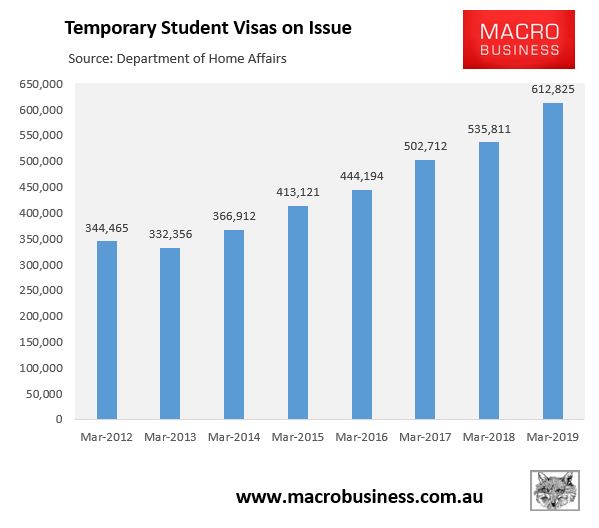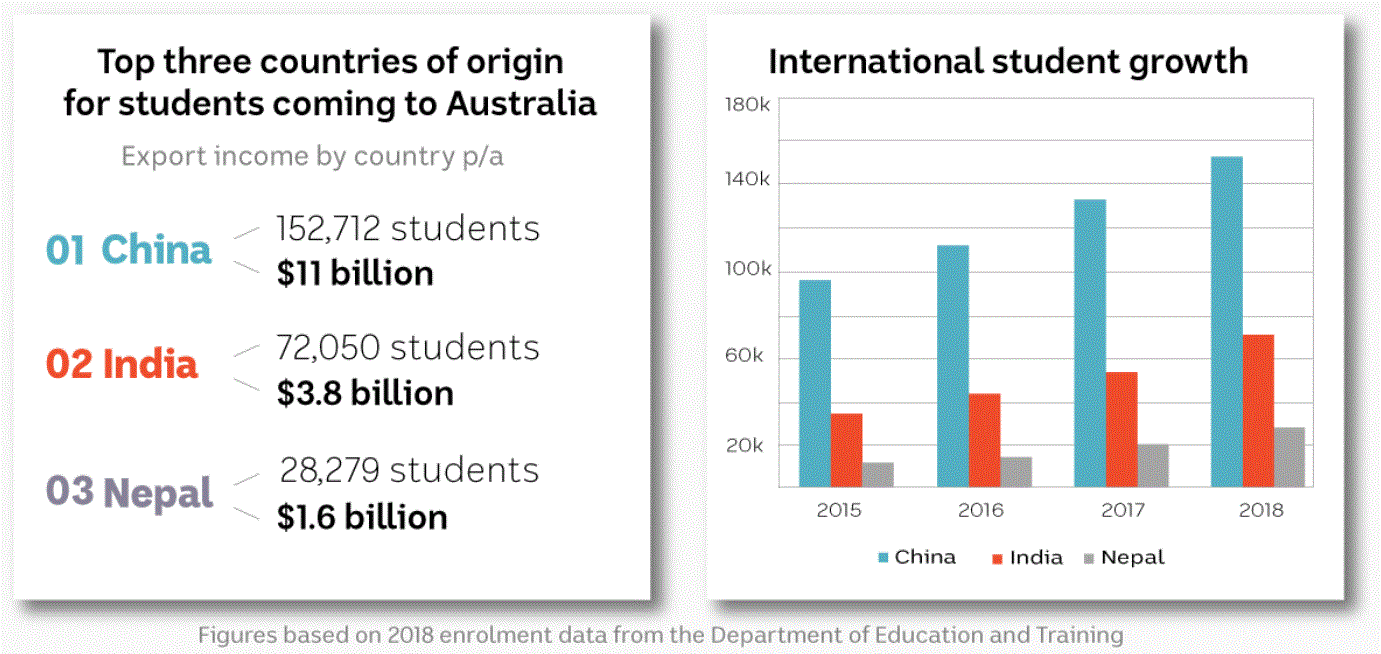The Department of home affairs’ latest quarterly visa data showed that international student numbers hit a record high 613,000 in the year to March 2019, up 77,000 over the past year and 280,000 since March 2013:

However, the composition of students is clearly shifting away from China towards India and Nepal, according to official government data:
New federal government data shows that the total number of Chinese students commencing courses in the first semester of 2019 is only 1.5 per cent higher than last year.
This compares to growth of 7.4 per cent last year, and 17 to 19.8 per cent growth in the previous two years… [However] overall numbers continue to grow, driven by strong interest from India and Nepal.
More than 199,000 international students commenced courses in the first three months of this year (corresponding to the start of the first semester), 9.6 per cent higher than last year. The number of commencing Indian students rose by 50 per cent to nearly 29,000 and the number of Nepalese students was up 27.6 per cent to nearly 13,000.
The total number of international students enrolled in the March quarter this year was 640,000, 11.1 per cent up on the March quarter last year… In the year to March, education exports were worth $36.6bn, 15.4 per cent higher than the corresponding period a year earlier.
As regular readers know, Australia’s international student trade has to date been powered by China, whose 153,000 students in 2018 were more than double that of India (72,000) and roughly five times the numbers from Nepal (28,000):

As shown above, the average yield is also much higher for Chinese students ($72,000) than it is for students from India ($52,700) or Nepal ($56,600).
The reason is simple: Chinese students tend to pay higher fees to study at higher quality Group of Eight Universities. On the other hand, students sourced from India and Nepal generally study at cheaper second-tier institutions or private colleges, often for the primary purpose of gaining employment and future permanent residency in Australia.
For example, last year it was revealed that applicants from the Indian Sub-Continent were using state-based migration schemes in Tasmania and the ACT for backdoor permanent residency into Sydney and Melbourne:
During recent months and years, a large number of prospective permanent residents – particularly international students from the Indian subcontinent – moved to Tasmania and the ACT for a relatively easier pathway to permanent residency…
This rorting was particularly prevalent in Canberra, where large numbers of Indian students streamed into the ACT to study at private colleges for one year and to qualify for permanent residency:
In July last year the ACT government widened the criteria for those seeking to be nominated by the territory government for permanent residency…
“When the subclass 190 visa popped up, the students started streaming in,” Min Gurung, marketing and sales manager from JP International College, in Mawson said. The college experienced an increase of 300-400 students in the past year, with many students moving to the ACT with their partners and young families…
Unity College in Belconnen experienced an almost two-fold increase in its student numbers to about 50…
Some operators of the colleges are reluctant to speak out, with one reporting his institution had about 100 students before July last year. In the past year, that number grew to about 300 students…
It’s believed up to eight colleges have opened in the past year and more applications could be in the works…
Last month’s Four Corners report was especially critical of the quality of students arriving from the Indian sub-continent, reporting widespread cases of academic misconduct, plagiarism, and students failing their courses.
For example, maths lecturer and academic misconduct investigator, Dr Duncan Farrow, told Four Corners:
“I have just reviewed the results for students from the Punjab region in BSC100 Building Blocks for Science Students and it is depressing. Of the 52 students in this category, 12 have passed the unit outright — a pass rate of less than 25 per cent”.
Murdoch University’s Professor Benjamin Reilly expressed similar concerns:
“In semester one 2018 we experienced a surge in new international students into some postgraduate courses. This surge increased sharply in semester two 2018, with several hundred new students, mostly from the Punjab region of India, enrolling in a small number of postgraduate courses.
“While some were OK, many do not have the language skills to study at a postgraduate level and have thus been unable to participate in class or complete assessments for the units legitimately.
“Hence we now have a much larger number of academic misconduct issues, supplementary assessments and outright failures than we have previously experienced in the units in which this cohort has enrolled”…
In a similar vein, Inside Story’s Tim Colebatch warned that large numbers of Nepalese students are flocking to Australia on spurious grounds, and risk repeating the training visa scams experienced a decade ago:
…one source stands out: the little Himalayan country of Nepal, just thirty million people, living in one of Asia’s poorest countries…
Over the five years to mid 2018, one in every 500 Nepalis emigrated to Australia — and that’s in net terms, after deducting those who returned. In 2017–18, little Nepal became Australia’s third largest source of migrants after India and China…
Deregulation has allowed universities to selectively lower their standards to bring in more fee-paying foreign students, even when they fail to meet the thresholds for English language skills or academic achievement…
This is not the first time immigration from Nepal has surged. A decade ago, we saw a scam with training visas, in which “students” from India and Nepal came for training courses in Australia, then quickly vanished into the workforce. The scam saw net immigration set record levels in 2008–09, before then immigration minister Chris Evans shut it down. But most of those who came stayed on here.
As reported in last month’s Four Corners report, some universities have been admitting international students who are below the university’s own published English standards, as well as accepting “medium of instruction” (MOI) letters for postgraduate students from India and Nepal, which state that students previously studied in English.
Some of these students are undoubtedly gaining access to Australia via fraud, as implied by the 2015 ICAC investigation entitled “Managing corruption risks associated with international students”:
In the search for international students, some universities in NSW are entering markets where document fraud and cheating on English-language proficiency tests are known to exist. They are using large numbers of local intermediaries – sometimes more than 200 agents – to market to and recruit students, resulting in due diligence and control challenges…
False entry qualifications, cheating on English-language proficiency tests, essay mills selling assignments, plagiarism, cheating in university exams and paying others to sit exams are reportedly common.
The pressures within universities are also conductive to corruption.
It’s not hard to see why. Across Facebook there are many advertisements by unregulated Sub Continental education agents spruiking how they can assist prospective students to manipulate the International English Language Testing System (IELTS) to gain entry into Australia’s universities (example below).

Given that Australia’s universities and private colleges are now scraping the bottom of the international student barrel, and bringing in lower quality (and lower paying) students from India and Nepal, surely this is a signal that the international student bubble is about to burst?
With Australia’s largest student source – China – topping-out, and increasing scrutiny on the sector following the Four Corners report, it’s only a matter of time before international student numbers begin to fall.

